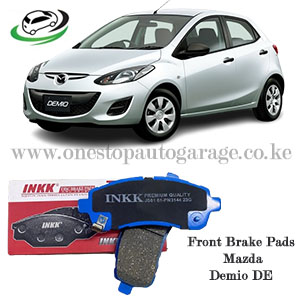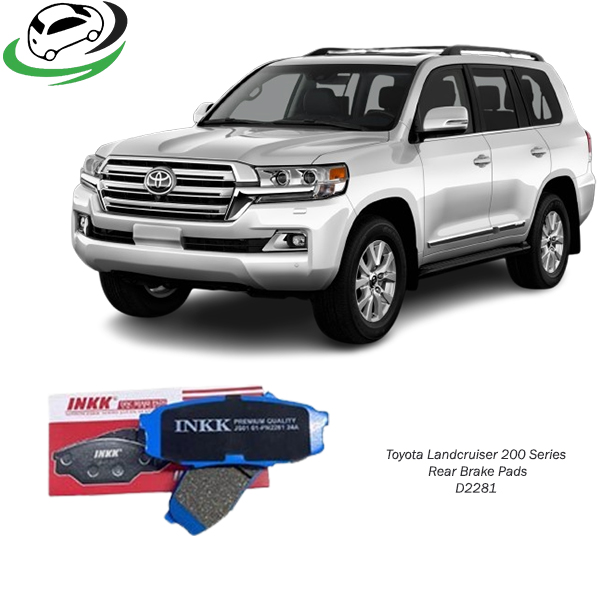-13%
Get Toyota Land Cruiser 200 Series Rear Brake Pads D2281
Brake pads are an integral component of a vehicle’s braking system, playing a crucial role in the safety and performance of the vehicle. Here’s a detailed exploration of brake pads, covering their function, types, benefits, signs of wear, and maintenance:
Brake pads are designed to convert the kinetic energy of a moving vehicle into thermal energy through friction, which slows down or stops the vehicle. When the brake pedal is pressed, hydraulic pressure pushes the brake pads against the spinning brake rotors, creating friction and decelerating the vehicle.
Benefits of High-Quality Brake Pads:
1. Superior Braking Performance
- Effective Stopping Power: High-quality brake pads provide consistent and reliable stopping power, which is crucial for safe driving. They ensure that the vehicle can stop effectively in various conditions, including wet, dry, and icy roads.
- Enhanced Control: Improved friction materials in high-quality brake pads allow for better modulation and control during braking, giving drivers more confidence and precision in their braking efforts.
2. Increased Safety
- Reduced Stopping Distances: High-quality pads can significantly reduce stopping distances compared to lower-quality options, enhancing overall safety and potentially preventing accidents.
- Performance in Adverse Conditions: High-quality brake pads maintain their performance under a wide range of temperatures and driving conditions, ensuring consistent braking performance even in extreme situations.
3. Durability and Longevity
- Wear Resistance: Premium materials used in high-quality brake pads offer better resistance to wear and tear, extending the lifespan of the pads and reducing the frequency of replacements.
- Heat Dissipation: High-quality brake pads are designed to dissipate heat more effectively, preventing brake fade during prolonged use and maintaining braking performance over time.
4. Noise Reduction
- Quieter Operation: High-quality pads are engineered to minimize noise and vibrations, providing a quieter driving experience. This is particularly important for drivers who value a smooth and quiet ride.
- Reduced Squealing: Better materials and design reduce the likelihood of annoying brake squeal, which can be a common issue with lower-quality pads.
5. Reduced Brake Dust
- Cleaner Wheels: High-quality brake pads produce less brake dust, keeping wheels cleaner and reducing the need for frequent cleaning. This helps maintain the aesthetic appeal of the vehicle.
- Aesthetic Appeal: Less brake dust means that wheels and surrounding areas stay cleaner for longer, preserving the vehicle’s overall appearance.
6. Environmental Impact
- Eco-Friendly Materials: Some high-quality brake pads are made from environmentally friendly materials, reducing the ecological footprint. This is important for drivers who are conscious of their environmental impact.
- Reduced Emissions: Cleaner and more efficient braking can lead to lower emissions of brake dust and other pollutants, contributing to a healthier environment.
7. Consistent Performance
- Reduced Brake Fade: High-quality brake pads are less prone to brake fade, which is the reduction in stopping power that can occur when brakes overheat. This ensures consistent braking performance even during long descents or heavy braking.
- Stable Friction Coefficient: High-quality pads maintain a stable friction coefficient over a wide range of temperatures and conditions, ensuring predictable and reliable braking performance.
8. Enhanced Vehicle Longevity
- Protecting Other Components: By reducing wear on the rotors and other brake components, high-quality brake pads help extend the overall lifespan of the braking system. This can lead to lower maintenance costs over time.
- Minimized Maintenance: The durability and efficiency of high-quality brake pads mean fewer replacements and less frequent maintenance, saving time and money for the vehicle owner.
9. Improved Fuel Efficiency
-
- Less Drag: High-quality brake pads are designed to operate efficiently with minimal drag, which can improve fuel efficiency slightly by reducing the effort required from the engine to overcome braking resistance.
1. Squeaking or Squealing Noise
- High-Pitched Sound: A high-pitched squeaking or squealing noise when applying the brakes often indicates that the brake pads are worn. Many brake pads have built-in wear indicators that emit this sound when the pads are nearing the end of their service life.
2. Grinding Noise
- Metal-on-Metal Sound: A grinding or growling noise when braking usually means the brake pads are completely worn down, causing the metal backing plate to contact the brake rotor. This can damage the rotors and requires immediate attention.
3. Longer Stopping Distances
- Decreased Braking Performance: If you notice your vehicle takes longer to stop than usual, it may be due to worn brake pads. This reduced braking efficiency can be dangerous and should be addressed promptly.
4. Vibration or Pulsation
- Uneven Braking: A vibration or pulsation through the brake pedal when braking can indicate unevenly worn brake pads or warped rotors. This issue often requires both the pads and rotors to be checked and possibly replaced.
5. Thin Brake Pads
- Visual Inspection: You can visually inspect the brake pads through the wheel spokes. If the pad material appears to be less than a quarter of an inch (about 6.4 mm) thick, it’s time to replace them.
6. Indicator Lights
- Dashboard Warning Light: Many modern vehicles have a brake warning light on the dashboard that illuminates when the brake pads are worn out or if there is a problem with the braking system. Consult the vehicle’s owner’s manual to understand the specific warning lights.
7. Pulling to One Side
- Uneven Wear: If the vehicle pulls to one side when braking, it can indicate uneven wear on the brake pads or a problem with the brake calipers. This can affect vehicle control and should be inspected.
8. Spongy or Soft Brake Pedal Feel
- Soft Pedal: A spongy or soft brake pedal feel when you apply the brakes can be a sign that the brake pads are worn and not making proper contact with the rotors. It can also indicate issues with the brake fluid or air in the brake lines.
9. Burning Smell
- Overheating: A strong, pungent burning smell while driving, especially during heavy braking, can indicate overheated brakes or worn-out brake pads. This smell is usually caused by excessive friction or metal-to-metal contact.
10. Visible Scoring or Grooves on Rotors
- Rotor Damage: If you can see or feel deep grooves or scoring on the brake rotors, it indicates that the brake pads are worn out, and the metal backing plates are digging into the rotors. This usually requires rotor resurfacing or replacement along with new brake pads.
11. Brake Pad Warning Sensors
- Electronic Wear Sensors: Some modern vehicles are equipped with electronic wear sensors embedded in the brake pads. When the pads wear down to a certain level, the sensors trigger a warning light on the dashboard, indicating it’s time for a brake pad replacement.
Follow us on Facebook for more parts.



